
BOMBAY TO TANNA(THANA)THE FIRST STEAM ENGINE PULLED TRAIN TOOK ONE HOUR
SEE:-STORY AND HISTORY OF -INDIAN TRAINS AFTER INDEPENDENCE :-http://pazhayathu.blogspot.in/2010/08/story-and-history-of-indian-trains.html
Abovefirst train Bombayand India
BBCIR / Western Railway Suburban System
Pictures of BBCIR and Western Railway suburban system of Bombay (Mumbai) from the yesteryears:-
A white Metro Cammell EMU rake of Western Railway arrives at Churchgate. Parked on the adjacent platform and ready to depart is an original 1928 Cammell Laird rake.
|
 |
| CHURCH GATE STATION |
The special train leaving the new Churchgate Station for Mahalaxmi after opening ceremony - 1957 (R Harish Kumar)
|

BBCIR Bombay suburban railway time table cover date 1908.12.01 The system extended from Colaba to Virar at this time.
|
IRFCA PHOTO GALLERY
BBCIR / Western Railway Suburban System
Album: BBCIR / Western Railway Suburban SystemMain line looking down gullet from N.W. corner, south jetty [Victoria Dock construction, Bombay 19TH CENTURY PHOTO
View of incline. Truck and engine with bottom girder of one gate going down to entrance [Victoria Dock construction, Bombay].
1969-BOMBAY CENTRAL STATION
Having left from Colaba RAILWAY STATION, this is the Frontier Mail steaming out of Bombay Central on her inaugural run on 1 Sept. 1928. The train now originates/terminates from Bombay Central, as Colaba station is no more in existance.
Old vintage 1900s sepia Colaba Reclamation and Station ; Bombay
On Armstice day[Armistice Day is the anniversary of the official end of World War I, November 11, 1918. It commemorates the armistice signed between the Allies and Germany at Compiègne, France, for the cessation of hostilities on the Western Front], a special 'Frontier Mail' was run by the BB&CI Railway from Bombay. Souvenirs were distributed to the passengers travelling on the train, which was then the fastest daily service in India. The restaurant car was tastefully decorated with poppies as a symbol of Armstice Day. In this pic, taken at the Ballard Pier Station in Bombay, Lady Jackson (wife of Sir Ernst Jackson, Agent, BB&CIR) is seen placing a bouquet of poppies on the engine of the special train. (Picture supplied by John Lacey.)
BOMBAY -General view of a new restaurant car for the Frontier Mail, circa 1929 , Interior of the car . One of the Frontier's restaurant cars was named 'Queen of Rajputana'.
Related photos hacked and removed
=====================================
How (Prestigious) Trains Ran in British India
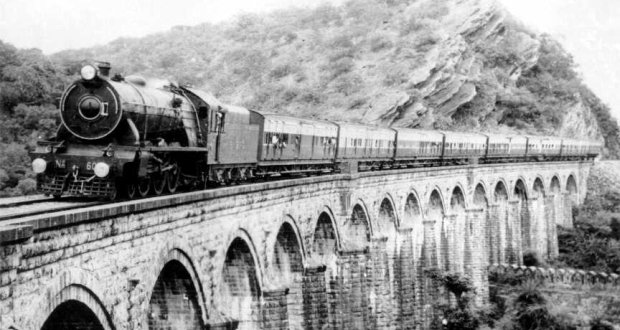
The Railways were a way of life during the days of the British Raj and the glorious history of the Indian Railways is handed down from there. Being sure that they would probably govern India forever, British-Indian Railway companies in the early days of the Raj invested heavily in India with the latest locomotives and equipment and by laying and expanding lines everywhere. It is said that the facilities available on trains in India in those days were better than even even those in England! But investments dried up after 1930 when the independence movement gained steam and by 1947 they left behind a dilapidated, run down and accident prone network with aging locomotives, rolling stock and infrastructure with a rusting and decaying track system. An era of global railways came to an end with Indian Independence. After covering how the Indian Railways’ history came to be in the last episode, here I try to shed some light on the trains and how they ran in India pre-1947. Those trains were the epitome of luxury run for and by the white sahib who lived and traveled in style unmatched even today anywhere in the World. All management positions were reserved for Europeans as were train engine drivers and most of other qualified technical positions. It was all hunky-dory for them but unfortunately it was not so for the Indians.
“Prestigious Trains” of the Raj
The most defining feature of the British India Railways was certainly the cult status accorded to certain “important” trains according to “prestige” accorded to them by name, a colonial hangover system still followed on today’s Indian Railways. Many attributes of “prestigious” trains like them getting priority on the track, having better accommodation, speed, lesser number of stops etc are all the legacies of those prestigious trains of yore. However those days “prestige” depended not on the class of the train but the class of the people traveling on them. Prestige status was accorded to those trains the elite and high officials of the British Raj regularly traveled on. The most important of these famous trains was the Frontier Mail running Bombay – Baroda – Delhi – Lahore – Peshawar, taking travelers deep to the edges of the Empire. Having only First and Second Class this was the elite of the elite trains in India with the most exuberantly opulent comforts. It was supposedly punctual to the dot and when it arrived in Bombay the entire station would be lit up to announce its arrival. Such was the association of this train with British snobbery that the Indian Railways of today decided to do away with even its name post-independence. The successor of the Frontier Mail today runs as the Mumbai Central – New Delhi – Amritsar Golden Temple Mail, but is still among the fastest and most prestigious non-premium trains on the route. Other “prestigious” trains of the day were the Mangalore – Peshawar (later Mettupalayam – Lahore and then Madras – Delhi) Grand Trunk Express, the Punjab Mail, the Indian Imperial Mail, the Flying Mail, the Boat Mail, the Deccan Queen, the Taj Express, the Flying Ranee and all Mail trains. Most of these famous and historic trains of past India still run today and are still given lots of prestige even today.
Picture Courtesy: Trainweb.org (Click on the picture for more such photos)
Classes of Accommodation in British India Trains
Trains in British India had four classes: First, Second, Third and
Fourth. First Class was defined by its incredible luxury with
wonderfully appointed plush carriages (coaches) divided into individual
cabins or suites whose ultra-luxurious interiors included carpeting,
electric lights, fans, wood-work, all paneling, royal-size beds/berths,
showers, servant quarters and all. Some even had rudimentary
“Air-Conditioning” where a big block of ice bought from the platform
could be lowered into a slot in the floor or roof and fans would be
directed at it for cooling effect! Only the most distinguished Europeans
could travel by First. Todays “elite” First Class AC
would seem like a general compartment compared to these. And unlike
those of today, the then first class carriages did not have corridors.
Each “cabin” as it is called today was a separate room or suite with its
own doors opening on either side of the carriage right onto the
platform. Each carriage (coach/compartment) could consist of a number of
such “rooms”. This was luxury at it’s best, a kind of opulence that is
not seen probably anywhere in the world on general trains today. Yes,
think Titanic, think James Bond’s (Sean Connery) train compartment in “From Russia, with Love“. These coaches were rumored to be in service until the 1980s.
Second class was almost as luxurious as the first but had only sitting arrangements with heavily padded and cushioned seats. Many might have been divided into cabins with wardrobes etc, accessible from a corridor. Some might’ve had no corridors with seats on either side. You can check any old British movie (Or Narnia, the first part) to see how these carriages looked like. It was the preferred mode of transport for the Europeans. Third class consisted of plain carriages with wooden benches meant for the lowly traveler. Most of these didn’t have lights, fans, toilets or even bars on the windows at first. Indians usually traveled in these and the coaches were filled with dirt and filth. . They were the general second compartments of today, but only far worse. Fourth class carriages were basically just empty boxcars with windows and without even benches, crammed with people to the brim in unimaginable conditions, worse than the third class and neither the other passengers or the Railways cared about them. Indians, wretched as they were seen as by the British could only afford and were allowed to travel only by third or fourth class while their overlords wallowed in luxury in First and Second class. Later, Fourth was abolished and a new class named “intermediate” or “inter” was introduced between Second and Third classes, which offered better seating for reasonably rich Indians and poorer Europeans with comforts a bit better than third class. Our General Second Class (Unreserved) compartments we see at either ends of express trains today are the direct descendants of these “Inter” coaches. Third continued as the dismal original Cattle Class until it was abolished post independence in 1955. Many trains had restaurant cars which could put to shame any 5 star restaurant of today, where you could snack on the best delicacies, Indian or European or whatever you fancied. Most trains had bars aboard and you could even get iced beer on call!
Picture Courtesy: Trains-Worldexpresses.com
Rolling Stock and Locomotives
Rolling stock was mostly wooden at first and later had more metal incorporated into them. There was no standardized uniform design as we see today and each railway company designed and made carriages the way they wanted as any woodworking shop of enough stature could build railway carriages as per order. Locomotives were entirely steam, those great imposing wheezing, hissing and chugging machines belching steam and smoke were the Boeing 787 Dreamliners or Airbus A380s of the day. People would gape at them and worship them awe-inspired as the definition of power, something they could not understand those days. The locomotives were mostly built by the Vulcan foundry and other British factories and shipped to India. I could not find a decent compilation of all locomotives used during those times. During WW 2, most of the better locomotives were shipped out of India, leaving the country with the worst of the lot by independence. There were a couple of diesel engines and 5 electric locos doing duty on the 383 km Mumbai – Pune route which was electrified way back in 1930. Another bewildering aspect was the near-total absence of shunting locomotives in India after WW2, so much so that elephants and even people were used to push wagons and carriages to shunt them! Such was the “great legacy” that the British left us. Our outdated locomotives had limited hauling power, and trains could have maximum 10 or so coaches. As they could not cut down on the number of high-class coaches, they cut down on the number of Third and Fourth class coaches, and guess who suffered?
We all know about timetables of the “prestigious” trains of British India. But there were hundreds of other trains as well, lowly passenger services and other sundry expresses connecting cities and hinterland. No one knows how they ran, if they ran at all, and how people traveled in them. It is not even known what emphasis was laid on safety, or any if at all. Coming to think of it, there are almost no records of any accidents that surely must have happened then as the technology was in its infancy. The only two recounts I could find was of an unknown train derailing and crashing somewhere on the Bhore Ghat after a siding catch failed and the Punjab Mail derailing at Bihta in Bihar. Details of both these records are conspicuously missing. When it comes to timing and punctuality, Mail trains used to run perhaps more or less on time because of their passengers and because of the mail it carried, which would have great implications if it did not reach it’s recipients on time. It is said that it was unimaginable for a Mail train to be late but it can only be imagined how the other trains were operated, the passenger trains and other long distance express trains. Trains had much lengthier halts in those days as many junctions did not have bypass lines, and the loco had to be turned around and most lines were single track where unimportant trains would be held up for Mails to pass. Also, trains needed to be filled up with water and higher class passengers had to be ferried to the restaurant cars, and if these were not available, to restaurants on the platform. Yes, waiting time for that was included in the timetable! I am sure many unimportant trains would have been running late by days altogether all the time!
However, the running rules of the Railways of those days had a profound impact on how Railways were run in independent India. The real legacy of the British-Raj era railways lies therein. We still have Railways divided on the class of reserved and unreserved. We also have operating rules directly inherited from the British and our trains run on those rules whose basics were laid down by the British. Those were the days when the Railways defined the World and as the British ruled the World with India as their largest colony, the railways of India was ground Zero for all the movers and shakers of the World. But all was not so rosy. The British might have done a good job of running the Railways pre-1930, but no one ever bothered to know how the non-British survived the railways. India and its real inhabitants were always left undocumented in the frenzy about the Romance of the British Railways by the Indian and the British elite alike. More about that in the next part.
Previous Part (02) – History of the Indian Railways: Pre-Independence
Indian Railways Pre-Independence History
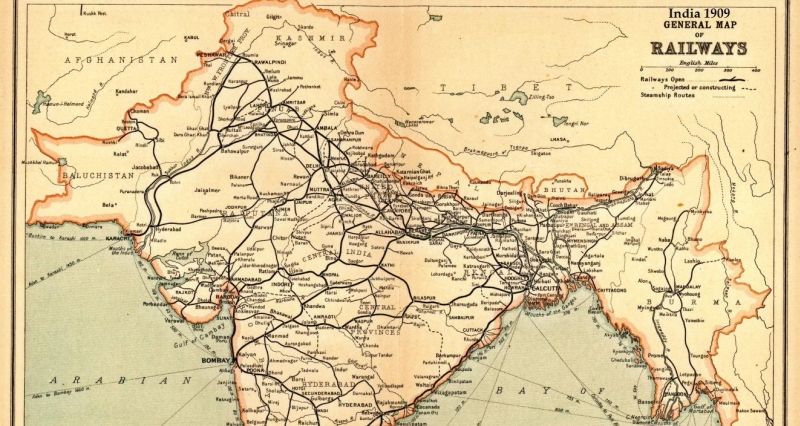
[dropcap]Those[/dropcap] two hundred years the British ruled India were also the most important years in world history, the period when the world was discovered, industrialized and transformed, the British driving this transformation, effects of which are still seen everywhere in the World today. It won’t be wrong to say that most of what we see today in modern India is the legacy of what the British left us: English, Cricket, the Constitution, the Bureaucracy, the Parliamentary system, the complex law structure, Civil Services, “Do the needful” and the fascination Indians have with white skin. Among these, the largest in material terms is of course, the Indian Railways. British influence is visible in the Indian Railways even today through operating laws, bureaucracy, paperwork and of course, speed. Instead of looking at the Railways as an entity of which everything is to be criticized because everyone has an opinion, I would like to look into the past for a while, the stories on how this giant organization came to be, the History of the Indian Railways.
How the Railways in India came to be.
The British created the Indian Railways. They envisioned it, planned it, engineered it and instructed poor Indian laborers how to build it. There is a common misconception that the British “gifted” India the Railways. Nothing could be more wrong. The British did not build the Railways out of love for India or seeing the need to “prosperify” vast masses of poor Indians. They couldn’t have cared less. In order to govern this huge, disconnected and diverse country efficiently, they needed stuff to be moved around the country quickly, like the mail of the Empire, materials, officials, laborers, troops and so on. During that time, the revolutionary new “Railway technology” in England was accelerating industrialization and development of the Kingdom. The British realized that an extensive railway network was exactly what they needed in India to consolidate their power, control the local population, reach into the hinterlands and exploit the country to the maximum. And this was what led to the beginning of the Indian Railways. Letting the local populace use the trains was just a generosity extended on their part. Yes, the British built their Indian empire not on the power of gunpowder, but on the power of steam.
The first rail lines were laid directed inland from major ports as those were the landing points for the British in the country. Later as lines extended further inland they were interconnected to form trunk-routes connecting major cities and towns. The British heartland lay in the Punjab, Delhi, the Northern Provinces (Present day UP-Bihar) and Bengal, all of which were also politically the most sensitive and required fast and easy access, the reason for the existence of the intricate and complicated rail network we see today in North India. The railways also entailed quick and easy transport of all the resources being shipped by the company, ranging from Timber, Cotton, Coal, Aluminum, Iron Ore, Tea, Rubber and Grains to Gold, Precious Stones, Wildlife and what not. Whenever a resourceful area was located, a railway line was built to connect that area to the nearest mainline to transport said resources. This explains the existence all the spurs on IR which end in the middle of nowhere. (Nilambur, Nanjangud, Bodinaikkannur, Tuticorin, Shimoga, Kolar, Ooty, Bellary, Anantpur and so on, stating the south).
The Beginnings of the Railways in India
As our textbooks say, the first commercial passenger train in India ran from Bombay “Boree Bunder” (later VT and today CST) to Thane on April 16th 1853, a 14 coach train hauled by 3 steam locomotives. But there were makeshift trains running before that in India as early as 1835. The first train was the Madras Redhill Railroad which was used to transport granite and other minerals somewhere around the present day Chintadripet in Chennai. Then there were railways laid for building the Godavari Dam and the Solani Aquaduct in Rourkee. Having decided to build a commercial rail network in India, the British-Indian government invited participation from private enterprise based out of England to build it and they were guaranteed 5% returns minimum. Several companies were incorporated, surveys were carried out extensively for viable routes and work on the line out of Bombay VT was started by the GIPR in 1852. Anyone could start a Railway company in India those days and build their own tracks to run trains for profit. These companies had no unified structure and used whatever type of gauge, type of equipment, rolling stock, classes of accommodation, fares and operational methods that suited them. So predictably it was a mess as there was no centralized control. Almost the entire early railway network in British India was built by the private sector until 1923 when the two largest companies were nationalized. Till then the government would take over profitable companies but then hand it back again for operations and so on.
The First Railway Lines in India and the Expansion
Between 1854 and 1899, several railway companies were incorporated and each began work on their own lines, pushing further and further inland from the coast. The biggest companies were GIPR (Great Indian Peninsular Railway) Bombay, EIR (East India Railway) Calcutta, MRC (Madras Railway Company) Madras, BB&CI (Bombay Baroda & Central India) Surat and others. EIR completed construction of the Calcutta – Delhi line via Allahabad in 1864 after 9 years of work and the first train rolled into Delhi Junction (DLI) the same year. But a regular train began running from Calcutta to Delhi only in 1866, was the precursor of today’s Howrah – Kalka Mail. BB&CI completed construction of a line from Ahmedabad to Bombay in 1867 and started a service from Virar to Bombay Backbay (present day Churchgate), probably marking the beginnings of what is today Mumbai’s most famous local train. By 1854, the very next year after the inaugural run, the Bombay – Thane line was doubled and extended up to Kalyan on the way to Igatpuri. But seemingly impossible Ghats obstructed the easy construction of a line out of Mumbai, and it took GIPR 10 years to finish the line across the Thal (Thull) Ghat section to reach Igatpuri. By 1870, that line had extended to Jabalpur via Manmad and Itarsi, where it met EIR’s Allahabad – Jabalpur branch line, completing the Bombay – Calcutta line. Meanwhile, GIPR was also hard at work trying to cross the Khandala (Bhore) Ghat to reach Pune from Mumbai.
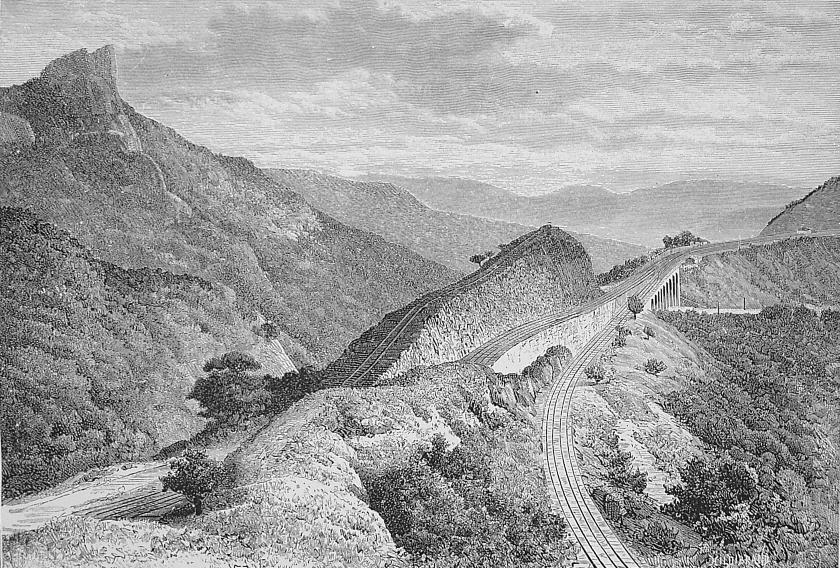
Picture Courtesy: Old Photos Bombay
In the South, the first line was laid from Royapuram in Chennai to present day Walajah Road (Arcot) by the Madras Railway Company, on which a train ran on July 1, 1856. The second railway line in South India ran from Beypur port (now defunct) to Tirur in North Kerala (Malabar) on March 16, 1861 and was built by the Great South Indian Railway (GSIR). The Madras Railway Company extended their lines across the Madras Presidency in all directions from Chennai and it reached Bangalore via Jolarpet in 1864. A regular service started running in 1864 between Madras and Bangalore Cantonment in 1864 and was called the Bangalore Mail. The train still runs today under the same name and roughly the same timings, making it probably the first regular named train service in India. MRC later would extend its line to Erode and Coimbatore from Jolapet. They were also extending northwards and by 1871 MRC had completed laying a line across the scorching plains of Andhra/Telangana from Madras to Raichur via Arakkonam, Renigunta, Kadapa and Guntakal. GIPR had overcome their troubles laying lines over the Khandala Ghat by then and their line had also reached Raichur via Pune, Daund, Wadi and Gulbarga. Both these lines connected at Raichur in 1862 completing the Bombay – Madras link, hence connecting the South to the North for the first time and “unifying” the country.
There was no looking back after that. Railway lines snaked across all over India at incredible speed and by 1900, undivided India had a whopping 24,000 km of Railway Track and more than 50 scheduled services. The British Government and princely states pitched in with their own networks. The Maharaja of Cochin sold his valuables to build and complete the 58 km Ernakulam – Shoranur line in 1902. The Nawab of Hyderabad built the Hyderabad – Raichur line with funds out of his own pocket. As India’s Railways grew more and more problems started arising due to the large number of railway companies and absence of unified command. The government started nationalizing the network and 1940 it had taken over almost all companies. By the time of independence in 1947, India had 53,000 km of railway track route, a veritable colossus built up on the power of steam, carrying 680 million passengers annually, connecting every part of the country and giving the people a common consciousness of “Indianness” for the first time since the Gupta Empire.
Some old photos of trains and railways in India from 1860 to 1900
The British Era Railways and the Indian Public
There were apprehensions by the English that the Railways in India would not earn as Indians were expected not take the trains out of superstition, caste-prejudice, untouchability, gender segregation etc, but they were proved wrong right from the beginning. The railways captured the fascination of the Indian public who took to the trains with full force. People started liking this new form of transport, faster than what they had ever experienced, allowing them to expand their horizons and visit faraway places they had never seen in their life in just some hours or days, leading them out of the darkness they had been living through generations. Indians piled upon all trains going anywhere to escape poverty and/or oppression, migrate to the cities and even abroad, visit relatives, on pilgrimage or just to go out and see places. Most trains were overcrowded in cattle class with people on the roofs, hanging off the windows and sides of railway carriages. Overcrowding was as much of a problem as it is today, so much so that Double Decker coaches were introduced as far back as 1862 on a Bombay – Surat train, the one which would become today’s Flying Ranee which incredibly still has double-decker coaches today!
However, the railways existed to serve British interests and not the Indian population. Other than some very very wealthy and distinguished ones, Indians were mostly not allowed on First and Second classes and were relegated to Third and Fourth classes, the real and original “Cattle Class”. There is a lot of “Romance” and other such rosy feelings associated with the British-Raj era railways as we know from the accounts of many writers, historians and other such folk who were of course all British. All said and done, blindly gorging on those would be a gross injustice we do to our ancestors, real Indians who lived and died in this country. The Railways were their toil, their blood and sweat, their creation, of all those undocumented and unknown people, whose lives and plights no one recorded. Like the hundreds of thousands who lived and died during those ages, they were easily forgotten by history because the Railways were always meant make the life of their British overlords easier.
Next: How Trains were run during the Raj, including accommodation types, rolling stock etc
More Episodes from Indian Railways Story Mainline
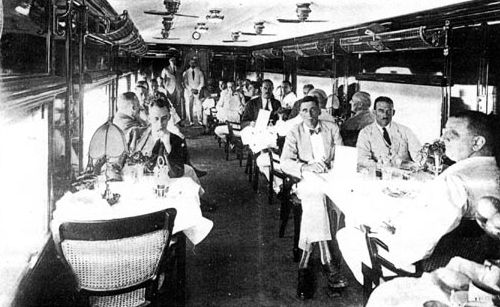
Dining car of Imperial Indian Mail, 1932
More photos of historical steam locomotives can be seen at the IRFCA Gallery.
Next Part (04) – The Railways of the British Raj – Romance and Reality
Railways of the British Raj: Romance and Reality
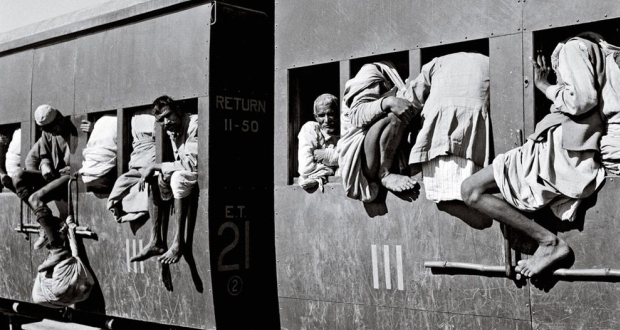
“History is written by the victor!” said Sir Winston Churchill, one of the greatest India-hating British statesmen ever. Much of Indian history was written by the British during the occupation and a large part of this is made up of tales which describe in excruciating detail the glamor and glitter of English life in India during the Raj while any detailed anecdotes describing the life and times of all the millions of forgotten everyday Indian people who lived during the British Raj is conspicuous by its absence. Did Churchill being the victor have anything to do with this blackout of the lives of the losers in Indian History? We will never know. But this blackout holds true even when it comes to the Railways during his era as well.
There are tons of British-written records about the history of the Indian Railways and on how they traveled in their plush First and Second class carriages but nothing on about how Indians traveled in Third and Fourth classes, save those written by Gandhiji. As we always do, we “solve” problems by closing our eyes and ignoring they are not there, and not by facing them head-on. Also, we try to connect to what is elite and glamorous, as that is where we want to be. Hence the endless depictions about how (in today’s words) awesome the trains of the Raj were, how romantic the journeys were and how the elite still pine for those days of History. But there were another set of people who lived at that time, ordinary Indians, our ancestors, who traveled in the Third and the Fourth classes of the trains, whose stories were and are largely forgotten by all those elite writers and historians who even today are obsessed with British-Raj romanticism. And those poor Indians were not in any position to write any accounts of their travels themselves anyway. Unfortunate is the fact that when you attain that snobbishness of wealth, you will only remember your snooty peers, forgetting those of the lesser being.
The Era of the British Raj Railways and Travel.
It was an era of gentlemen in top hats and coat tails and pretty ladies in gowns and parasols living up life with hoardes of servants and other associated entourage. An era of polished brass and varnished wood, of ridiculous Victorian etiquette and language. Of horrible elitism, pomp, show and glitter. And racism. And the English made sure that the trains in India provided them with the most advanced creature comforts they had at home back in the Kingdom. And since it was India, they wouldn’t even be bothered by pesky restricting factors such as human rights and equality under law that were in force in England. And they did build a vast empire through the railways. And at the height of their power, the mainstay of the empire was the the Railways, and they did travel in style…
The train would arrive majestically and in awe-inspiring grandeur, the locomotive chugging hot, hissing, spewing smoke and stream, the shrill whistle cutting through the air, the pistons driving long rods back and forth turning its enormous wheels leading it forward along the rails, almost making it a living creature. As the train hisses to a stop, the coach attendant would open the door for the most revered passengers. The servants scramble to collect the pile of luggage to haul on board the train while the the gora sahib and gora mem board their First Class compartment. It is resplendent in style with brass fittings, polished wood, fresh linen, wallpapers, carpeting, padded cushioning, wooden wall paneling, clean quarters, showers, toilet, wash basins, the works.
The gentleman sits down on an overstuffed chair and grandly lights a cigar, while the coach attendant asks: “Everything in order sir?” “Everything’s quite in order indeed, my dear James. Do bring my Whiskey, will you?” the sahib responds through his stiff upper lip.
Meanwhile on the platform, passengers disembark from the train and make their way towards the “European Refreshment Room” in the station for dinner. Yes, that “dinner time” was included in the timetable. The restaurants would be manned by Indians in smart uniforms speaking impeccable English, supervised by an Englishman, of course. Highest levels of everything would be maintained here. And of course, the “natives” were kept at bay.
“Oh! what is that terrible commotion out there?”
“Ah, it is the constable chap and his mates tying to get the native blokes down from the roof of the train. A regular occurrence, I am afraid. My apologies if it has brought sorrow to your delicate sensitivities, m’lady…”
No wonder the Indians were so overwhelmed by all this. You can read these accounts here on more detailed explanation about the Railways-travel of the Raj, all by British authors, and this one here, where an elite Indian pines for the bygone golden days. The trains of the British Raj promised “romance and adventure” to the passengers. Yeah adventure it was, sure, only more like Disneyland.
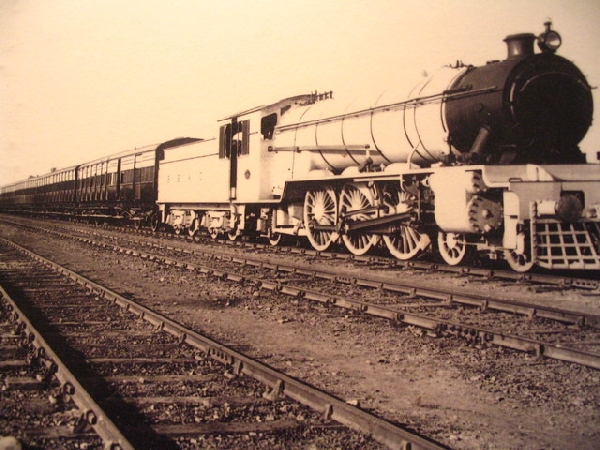
The Reality of Those Overly Romanticized British Raj Trains
However glamorous, romantic and nostalgic they might have been, Railways in the British-Era thrived on appearance, show, snobbery and horrible elitism. Well, this is nothing much different from what we have now, but the difference is that this was probably the rule back then. The Railways were created to serve the British and their needs and to make their life easier for them. Officials of the Raj who were entrusted with governing the country obviously would have been grumbling about it, given the extremities this country presented them with. Right from the scorching heat, dust, cold, rains, language, culture, terrain and geography, unavailability of creature comforts and so on, India was a world far apart from industrial England, the most developed country of the time. Hence, the first task of all the institutions set up in India by the British, including the Railways was to make the lives of the British people comfortable. All stops were pulled out to provide the best creature comforts to high class passengers. Of course, it is unimaginable that the “aam aadmi” Indian could be allowed to travel in higher classes, lest should the delicate sensitivities of the Sahib or Madam be offended. Indians were destined to rot in the lower class compartments which lacked even bare necessities. This formed the foundation on which the History of the Indian Railways was written. Maybe, seeing how easily the British of those days could get offended is why we also get offended for anything and everything today. Or maybe that stems from our inferiority complex that we developed over the centuries of foreign rule. Anyway that is a topic for another day.
The British legacy of romancing the trains rubbed on to elite Indians of the day and was promptly handed down the hierarchy. Some elites of even today dream about those “wonder years”, not realizing or conveniently forgetting that their ancestors might have been among the ones who were hanging precariously to the roofs of trains, black with soot emanating from the locomotive or crammed together in airless, light less, sooty and filthy Third (or even Fourth) Class compartments. People are still stuck on how “neat”, “clean” and on-time trains were those days, how the service was “excellent, by Jove“, and how romantic it might have been waking up on a plush bed in a well-appointed First Class cabin, early at dawn while it was still cold, listening to the chugging of the locomotive, looking out of the window to see the Taj Mahal as the first rays of the sun cut through through the mist… “Ah! That is the material out of which solemn dreams are made up of, impeccably, my dear Edward!” Conveniently, they forget that the vast majority of people on the train were traveling in compartments that had never even seen water and full of dust, dirt, spit, smoke and excreta. The British couldn’t have cared less for sub-human conditions in cattle class
Do you think today’s general Second Compartments are too “yucky” for your sensitive aesthetic sensibilities? Then you are no better than the pompous English of those days, my dear. And compared to the Third Class of those days, today’s General 2nd passengers are literally wallowing in luxury. Don’t believe it? Then, you should read this. Some excerpts:
“At one place an important railway servant swore at a protestant, threatened to strike him and locked the door over the passengers whom he had with difficulty squeezed in. To this compartment there was a closet falsely so called. It was designed as a European closet but could hardly be used as such. There was a pipe in it but no water, and I say without fear of challenge that it was pestilentially dirty.”
“The compartment itself was evil looking. Dirt was lying thick upon the wood work and I do not know that it had ever seen soap or water.”
“…every time you walked on the floor or rather cut your way through the passengers seated on the floor, you waded through dirt.”
And so on. All this while people were salivating about clean linen, ice-cooled cabins and glamour at the other end of the train. All said and done, no one cared about the common Indian and how he traveled, if he lived or died. All this “Romance” nonsense was perpetuated by people with vested interests to propagate the greatness of the British Empire at home and abroad. As the reigning World Superpower, it was obliged to do so, I guess. But while Indian elite and the British were busy romancing the trains, ordinary Indians didn’t give a damn because they were too busy trying to stay alive.
Photo Courtesy: National Geographic
Who Built up the Railways?
Of course, the English did. They spent the money, they made the decisions, they did the engineering, they planned the routes, they supplied the raw materials, they created the tools, they trained laborers and so on. But, who did the actual building on the ground? Our ancestors. To create a railway track, the ground has to be flat. If there is an incline, it has to be gradual. Earth will have to be cut down in some areas while it has to be brought up in others to lay the track level. The track has to be cut through the terrain, no matter how uneven and diverse it might be. It might be soil, sand, mud, rock, stone, jungle, swamp, vegetation or whatever. In these days of Dynamite, earth movers, huge dump trucks and other assorted heavy construction equipment, this might not seem like much of a challenge, but we are talking long before any of these came in into existence. In those days, all this was cut out and built using bare hands. Manually, using pickaxes and shovels, baskets and buckets. Another facts that British-Romanticists conveniently forget.
And they laid almost 1000 km of line a year, 3 km of line in a day. Tunnels were cut out by hand, rocks were broken up and Earth was carried on head for kilometers…Imagine how they must have built the tracks across the scorching plains, mountain ranges and swampy forests. Imagine how they would have worked, braving the incredible heat and cold, without any substantial nourishment, tools or safety measures. There are absolutely NO records of the workers who built our railways, who they were, where they were hired from, how many died and what became of their families, people picked up from somewhere by the builders as disposable labor. In all probability, most of the poor people who live adjacent to Railway tracks in small settlements must be ancestors of the original railway builders… Yes, it is our blood and sweat that built up the railways. The next time you travel on a train, look outside an imagine how it must have been to build all that, with bare hands.
History, Heritage, Pride and Romance… Even Today!
There are two sides to every coin. Indian Railways, as an organization has a lot behind it, in terms of history, the sweat and toil of its many men and women, Indian and English. That is what makes is great, that is its heritage, and not of some pompous Englishmen traveling in a ridiculously luxurious First Class compartment. Neither is it about brass fittings or polished wood. The legacy that was started by occupying colonial forces was reinvented by the occupie, and has developed into what we see today. There is still a lot to go forward, but there is always time. If there is anything people miss more than First Class romance, it is the romance of the “real old India”, which has got nothing to do with the British. The times of quaint old “small” trains which would chug along leisurely at their own pace, where no one was in a hurry and everyone stopped to smell the roses… That is real romance. And it still survives in many parts of the country. No, I am not talking just about the Nilgiri Mountain Railway or the Darjeeling toy train, but forgotten ones like the one shown below. The little NG train consisting of little coaches of many colors and a curious loco with a whistle, which makes it rounds along the plains in no hurry. The rustic old-worldness and delightful sounds takes you back to another age, no? Sadly, this too will disappear in time, slowly relegated to history by the wheels of progress.
But I tell you, the romance of the train journey is still present, more full in force than it ever was during the British times. Just pick a route, train and class of your fancy, stop cribbing and embark on a journey with an open mind. You will see. Don’t believe “Romance” can be complete only if it is associated with luxury! That is snobbery, elitism and closing one’s eyes to reality.
And be grateful you are alive today. Because, you would have never had experienced a “romantic” train journey if you were born during the British Raj.
Indian Railways History – At Independence

Though railways had already existed in India for a Hundred years before Independence, the real history of the “Indian Railways” as a single entity starts with Indian independence from British rule in 1947. The railways of the British Raj were not one single entity as we see today. There was no uniform railway system, there was no single body in charge, there wasn’t even a uniform fare structure! This is because the government had almost nothing to do with administration of the railways. The British built the Railways but it was not the British Government. The British Raj railways were an overwhelmingly private network with 52 companies running a bunch of trains on their own respective lines of all kinds of gauge and systems and coaches according to their own rules, entirely for profit. The trains ran across the country to carry the loot, serve British interests and make some money and keep the Gora Sahib happy. The British invested heavily in the Railways in India until the day they realized that they had to actually one day grant India independence. Once this realization dawned upon them they stopped investing and let the railways and the rest of the country rot. At the time of independence, all assets that were under the British in India were transferred to their respective Indian counterparts including the Railways. But contrary to popular belief, not everything was rosy out there. And I am not even talking about the trauma of partition.
By around 1930 with the boycott of the Simon Commission, the declaration of “Poorna Swaraj” and with the increasing noise against their rule, it became clear to the British that they could not go on governing India forever and would have to grant us independence eventually. As a result they started to slow down their long term investments in India which included those in the Railways. The Great Depression which hit the West during this time only positively influenced this decision. Almost no new substantial lines were built from 1930 to 1947 except the ones which were already under construction and many proposed projects were canceled. Then the Second World War rolled around which hit Britain hard and which also spelled the end of British Rail in India. During 1939, 40% of locomotives and rolling stock in India (obviously, the better ones) were put on ships and transported to the Middle East to help British war efforts. Railway lines were closed and many services discontinued as rails and other equipment were cannibalized for the same cause. Railway factories were rejigged to produce military equipment instead of Railway stuff. All this led to a huge shortage of locos, coaches and wagons, leaving India with old, obsolete, derelict and run-down locomotives and rolling stock. A large number of trains were permanently cancelled forever and many stations, routes and lines were shut down. Most of what was not dismantled and exported was left to rust.
The Indian Railways at the time of Independence
Contrary to what is widely believed, the supposedly “glorious” Railways that India inherited from the British was in reality a highly complicated, irregular, aging, outdated, decrepit, decaying and very diverse network, a big mess to say the least. There were 52 different railway companies in India which operated independently of and competing with each other. Many of these were owned by the British Government, some by British companies, some by Indian companies and some by Princely states. The network that existed then was a patchwork of 5 different gauge types (Broad, Standard, Meter, Narrow and Very Narrow). All imaginable kinds of rolling stock constructed in all kinds of configuration and made out of wood or metal or both were in use. Then there was the mish-mash of Indian and foreign locomotives, 95% of which was old steam with some electrics and the odd diesel thrown in. Fare structures, train numbers, routes, timetables and operations were more complicated than Nuclear Physics. As the West had largely moved on to Diesel and Electric from Steam, almost all non-suburban services (a whopping 99%!) in India were still running on wheezing steam locomotives. In 1950, there were 8120 steam locomotives, 72 electric locomotives (almost all were suburban EMU local trains) and just 17 diesel locomotives in India (source). Also, only 388 km of the entire route length was electrified at independence, a paltry 0.72%, with Mumbai – Pune being the ONLY electrified non-suburban route in the country. Most of the track length was Meter Gauge with Broad Gauge coming in a close second. The total track route in undivided India at independence was around 83,000 km, out of which a large share (25,000 km) went to the newly created state of (East and West) Pakistan. What remained in present day India was around 54,000 km of track.
There was a total absence of any kind of modern technology, safety standards and such, as investments in the railways were on hold by the British for almost 15 years. Add to that the unavailability of locomotives, rolling stock, technological know-how of any kind and the decaying rails and network. In short, at the time of Independence, the Railways in India was still stuck in the primitive age with little modernization to talk of. We did not have any knowledge of how to really run the entire thing and had to set up factories from scratch to build locomotives and rails. Later, it would be the Americans who would teach us how to make locomotives and the Swiss would provide us with world-class (at the time) coaches and rolling stock. It is not much known that India had to spend decades re-building the entire network which was decaying and in serious disrepair, run down to its bones with lack of maintenance, modernization and fresh hardware.
Indian Railways and the Partition
The Partition of India changed everything the subcontinent forever including the Railways. As per the line and map drawn up by Sir Cyril Radcliffe dividing India, 8070 km of line from the erstwhile Northern Frontier Railway went to the newly created state of (West) Pakistan and almost all of the Assam-Bengal Railway went to East Pakistan (Now Bangladesh). The partition cut through many railway lines and as a result the entire North-Eastern part of India was cut off from the rest of the country as all lines leading there passed through the new state of East Pakistan (Present day Bangladesh). As the disturbance around the partition grew into full-scale communal rioting, all normal operations were disrupted as the Railways focused at trying to move the tens of thousands of refugees between India and the two Pakistans in the midst of the massacre and genocide. And they were also entrusted with the unenviable task of dividing the railways in the middle of all this mess. Personnel, property, lines, equipment, assets, rolling stock and such had to be divided between the two dominions, along with transportation of documents, files, personnel and other railway related stuff. I still wonder how hey managed to achieve all that! The Railways were the symbol of hope and escape for refugees caught in between the rioting on both sides and played a pivotal role during the partition and leaving a lasting impression when it comes to images and lore relating to the partition. Railway stations and trains were the center points for rioting in many cases as this was where refugees would come to escape. I am not going into the horrors that happened during that time. Despite the acute shortage of everything, the Railways transported 4.7 million refugees in 1947-1948, something that was never heard of before in history. Read more about railways and the partition here.

Once the dust settled after the partition, the Railways lay in tatters along with the rest of India. Most of the lines, locomotives and rolling stock were damaged or unusable, much went missing and on the wrong side of the border. There was a severe shortage of fuel and a lot many of the staff had either fled or were missing after the rioting. We had to start from scratch. We needed new locomotives, new lines, Assam and Kashmir needed to be linked with the rest of the country and we had to overhaul the entire network. But first, we needed a properly organized and centralized authority for that, something that had never existed in India before. All those 52 (42 as per some) companies had to be nationalized, integrated and merged and a central authority had to be created which would run the Railways. Also, new stock had to be procured, lines laid and replaced and coaches had to be made, modernized and standardized. All this must have been a mammoth accounting task and bureaucratic nightmare that took years to complete. But it did complete, and the Indian Railways was born! We were off to a flying start any by the 1960s, Indian Railways were comparable to any modern railways in the World. But then complacency much settled in as we rested on our laurels. Another spurt of modernization happened in the 1970s but after that Indian Railways slipped much and went into rot. More about all that coming up in the next episode!
Apart from catering, the catering company was also expected to service the rest rooms at various stations in Gujarat. Since the dining car service was offered to first class passengers only, every single detail had to be taken care of. Any tarnished cutlery was sent for replating. Any chipped crockey too was promptly discarded.
Separate menu cards were provided for breakfast, luncheon and dinner.
It was a joke in the railway circles of yesteryear that if a youth wanted to lure his lady love into eloping with him, he would entice here to ride on the Frontier Mail. Even today, the Frontier is a much favored train among honeymooners, due to the cosy coupes offered.
1934-FIRST AIR CONDITIONED TRAIN[ Frontier Mail ] IN INDIA USED ICE BLOCKS TO COOL THE TRAIN
Golden Temple Mail (PT)/12903 Travel Forum - Railway Enquiry
The competition between the BB & CI and GIP Railways is almost legendary. As long ago as 1855, when the GIP Railway was struggling to obtain approval from England for construction of a line across the Western Ghats, the rival BB& CI Railway jumped in with its proposal that an alternative route via Baroda would be more practicable, it would avoid the arduous ghats, and this new line could connect with the East Indian Railway, something which the GIP Railway had been hoping to achieve once it got permission to cross the ghats anyway. Beginning with that, the competiton carried on till both the Railways had their own trains running from Bombay to Peshawar: the GIP's Punjab Limited, and now the BB & CI's Frontier Mail.
FIRST AIR CONDITIONED COMPARTMENT [INDIANS WERE ALLOWED INSIDE?! OR WAS IT ONLY FOR THE WHITE MEN?}

This "Rex" car is the modern version of an express refrigerator car
Videos
"Fearless" Nadia in "Miss Frontier Mail"(1936)
 56:04Miss Frontier Mail Old Hindi Full Movie ...youtube.com
56:04Miss Frontier Mail Old Hindi Full Movie ...youtube.com
STORY OF PUNJAB MAIL:-
PUNJAB MAIL-BOMBAY VT - FEROZEPORE[The Punjab Mail in the 1930s behind an EA/1 (later WCP/1) locomotive]
Bombay-Poona Mail, Great Indian Peninsular
1891
The Dapoorie Viaduct on the original line in 1855 -~1853 – The first passenger train of the Great Indian Peninsula Railway left Bori Bunder station in Bombay for Tannah. The train took 57 minutes to reach Tannah, covering a distance of a distance of 21 miles (33.8 km). 3 locomotives named Sultan, Sindh and Sahib pulled the 14 carriages with 400 passengers on board.
Railway Bridge on Bhore Ghaut Incline.--Photographer: Unknown Medium: Photographic print Date: 1855
photograph of a view of the Bhore Incline, near Bombay from the 'Vibart Collection of Views in South India' taken by an unknown photographer about 1855. India’s vast railway network is an enduring legacy of the East India Company. In 1853 there were 32kms of tracks, whereas by 1948 there were nearly 50,000kms. The railway connecting Thana through the Thal and Bhor Ghat inclines was the initiative of George Clark, Chief Engineer of the Bombay Government. The Great Indian Peninsula Railway Company developed the scheme in the 1840s and the Bhor Ghat pass was opened in 1861 as the main route over the Western Ghats linking the sea coast with the Deccan.
Railway Bridge on Bhore Ghaut.--Photographer: Unknown Medium: Photographic print Date: 1855 
Railway tunnel, near Khandalla. 
Ghaut scenery, with distant view of railway cutting
khandala station [ 1860?]
First GIPR[GREAT INDIAN PENINSULAR RAILWAYS=NOW CENTRAL RAILWAY] EMU, 1924--BOMBAY TO POONA[PUNE]
View of the Bhore Ghat, from a photograph at the India Office, London. Scan provided by John Lacey.
GIPR trains (one freight, one passenger) on the Bhore ghat, 1929. Scan provided by John Lacey.
an inspection car on the 2' 0" Neral Matheran line
Bhore Ghauts.--Photographer: Unknown Medium: Photographic print Date: 1855[before railways were built]
A photograph of a view of the Bhore Ghauts near Bombay from the 'Vibart Collection of Views in South India' taken by by an unknown photographer about 1855. The reversing station on the Bhore Ghat Incline under construction, with the hill known as the Duke's Nose in the distance. The idea of a railway to connect Bombay with Thane, Kalyan and with the Thal and Bhore Ghat inclines first occurred to Mr. George Clark, the Chief Engineer of the Bombay Government, during a visit to Bhandup in 1843. But it was not until 1856 that Bhore Ghat, 15.75 miles in length was begun under the direction of engineer William Frederick Faviell. The work was continued by Solomon Tredwell after Faviell's death in 1859. About 42,000 workers (peak of 1861) including many tribals, 32 different classes of artisans & labourers (10,822 drillers/miners, 2659 masons, buttiwalas to load & fire blasts, storekeepers, timekeepers, interpreters, filemen, platelayers, trumpeters for mustering people, thatchers, harness makers etc worked here. Coolies travelled on an average of 15-20 miles a day and carried an estimated 6,296,061 cubic yards of earthwork on heads.
The most magnificent railway station in the world, Bombay, India--Photographer: Ricalton, James Medium: Photographic print Date: 1903
View from N.E. corner looking S., forming with A [print 44], a complete panoramic view of works from N.E. [Victoria Dock construction, Bombay].-Photographer: Taurines, E. Medium: Photographic print Date: 1887-
Khandalla on the Bhore Ghaut, Bombay.--Photographer: Unknown Medium: Photographic print Date: 1860
his print was taken by an unknown photographer in the 1860s. It shows a view of Khandala, a small hill station in the state of Maharashtra, within the Sahyadri Mountains. In the nineteenth century such hill resorts became the favoured retreats of the British
The Frontier Mail of yore leaving Mole Station in 1928 at the start of its very long journey to Peshawar (which is now in Pakistan). Today the train runs upto Amritsar, and has been renamed the Golden Temple Mail.
R




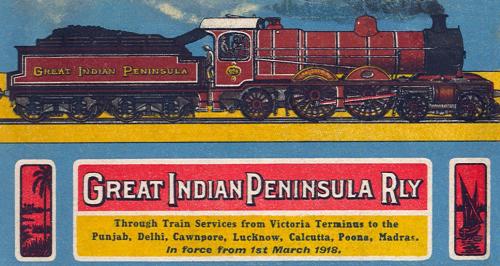
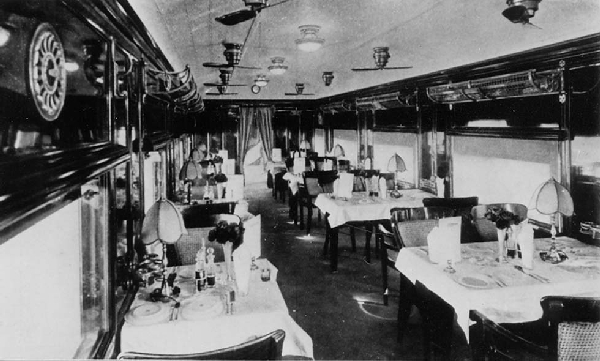

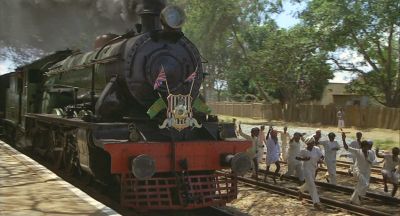
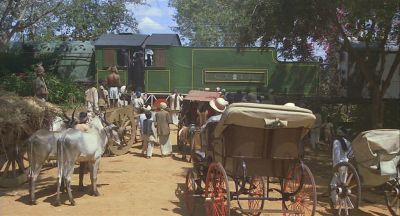
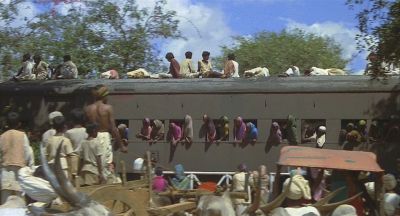
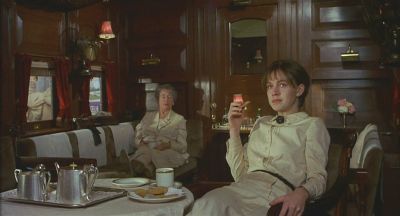
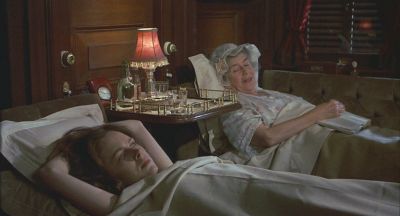
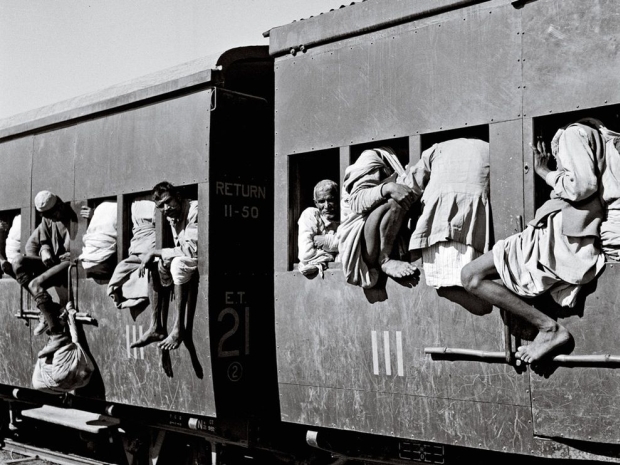







![Image result for 1934-FIRST AIR CONDITIONED TRAIN[ Frontier Mail ] IN INDIA USED ICE BLOCKS TO COOL THE TRAIN](https://st.indiarailinfo.com/kjfdsuiemjvcya22/0/9/6/2/3597962/0/mainqimg7de2c2336eb125196db1a1e37c89650bc55656.jpg)




